Tesco's Operations Management: Principles, Six Sigma and Improvement
VerifiedAdded on 2023/06/13
|18
|4215
|262
Report
AI Summary
This report analyzes Tesco's operations management, focusing on the application of six sigma and lean principles for continuous improvement and organizational growth. It examines how Tesco implements operations management principles, including procurement, logistics, marketing, and sales, supported by infrastructure, HRM, and technical departments. The report details Tesco's operational processes, emphasizing the transformation of inputs into outputs and the importance of customer feedback. It also discusses key principles like reality, organization, humility, success, accountability, causality, fundamentals, variance, managed passion, and change, and how Tesco integrates these into its operations. Furthermore, the report explores Tesco's use of six sigma to reduce errors and improve quality, highlighting the importance of defect identification, process capabilities, and operational stability. Finally, it proposes a continuous improvement plan, emphasizing the contribution of all employees and focusing on problem-solving and innovation to enhance Tesco's performance.
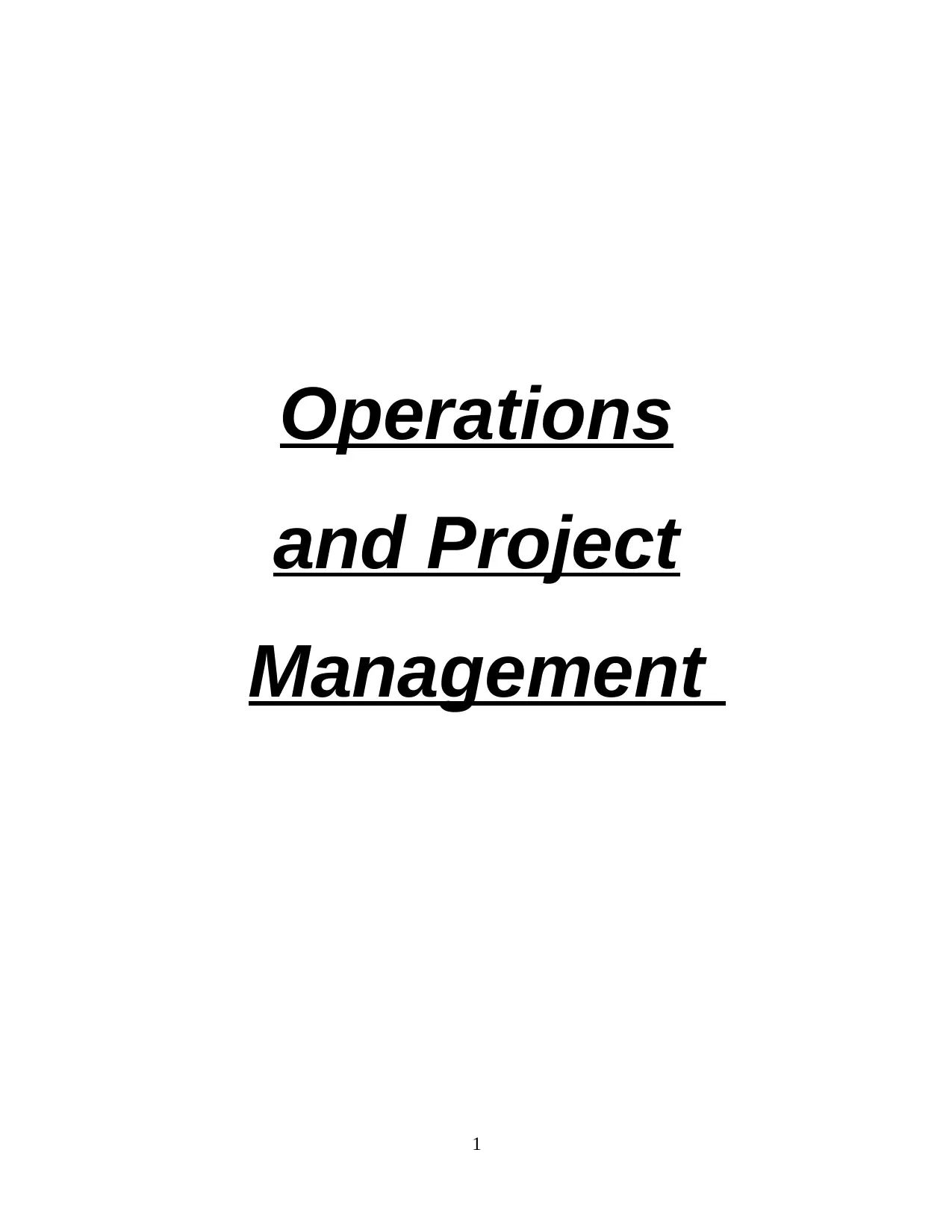
Operations
and Project
Management
1
and Project
Management
1
Paraphrase This Document
Need a fresh take? Get an instant paraphrase of this document with our AI Paraphraser
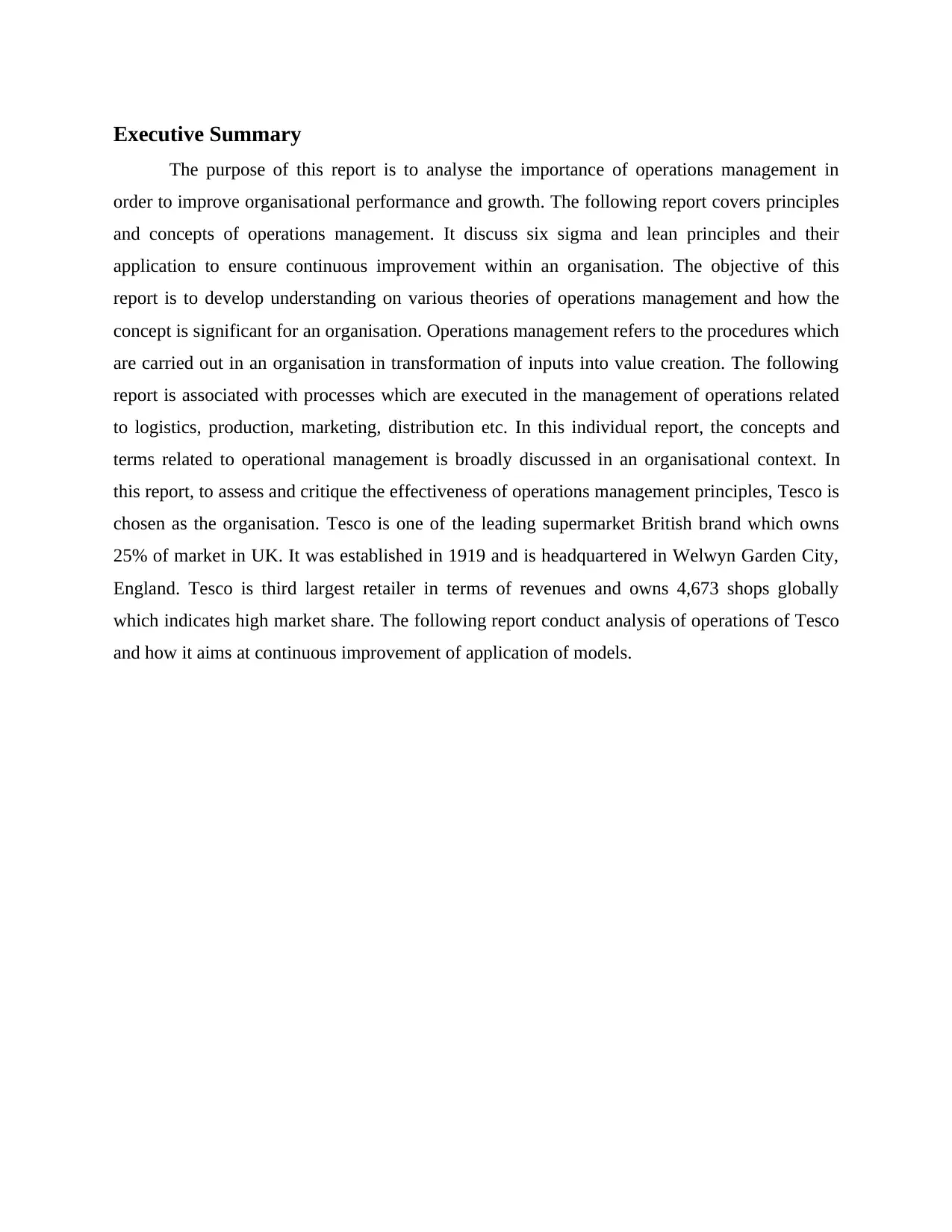
Executive Summary
The purpose of this report is to analyse the importance of operations management in
order to improve organisational performance and growth. The following report covers principles
and concepts of operations management. It discuss six sigma and lean principles and their
application to ensure continuous improvement within an organisation. The objective of this
report is to develop understanding on various theories of operations management and how the
concept is significant for an organisation. Operations management refers to the procedures which
are carried out in an organisation in transformation of inputs into value creation. The following
report is associated with processes which are executed in the management of operations related
to logistics, production, marketing, distribution etc. In this individual report, the concepts and
terms related to operational management is broadly discussed in an organisational context. In
this report, to assess and critique the effectiveness of operations management principles, Tesco is
chosen as the organisation. Tesco is one of the leading supermarket British brand which owns
25% of market in UK. It was established in 1919 and is headquartered in Welwyn Garden City,
England. Tesco is third largest retailer in terms of revenues and owns 4,673 shops globally
which indicates high market share. The following report conduct analysis of operations of Tesco
and how it aims at continuous improvement of application of models.
The purpose of this report is to analyse the importance of operations management in
order to improve organisational performance and growth. The following report covers principles
and concepts of operations management. It discuss six sigma and lean principles and their
application to ensure continuous improvement within an organisation. The objective of this
report is to develop understanding on various theories of operations management and how the
concept is significant for an organisation. Operations management refers to the procedures which
are carried out in an organisation in transformation of inputs into value creation. The following
report is associated with processes which are executed in the management of operations related
to logistics, production, marketing, distribution etc. In this individual report, the concepts and
terms related to operational management is broadly discussed in an organisational context. In
this report, to assess and critique the effectiveness of operations management principles, Tesco is
chosen as the organisation. Tesco is one of the leading supermarket British brand which owns
25% of market in UK. It was established in 1919 and is headquartered in Welwyn Garden City,
England. Tesco is third largest retailer in terms of revenues and owns 4,673 shops globally
which indicates high market share. The following report conduct analysis of operations of Tesco
and how it aims at continuous improvement of application of models.
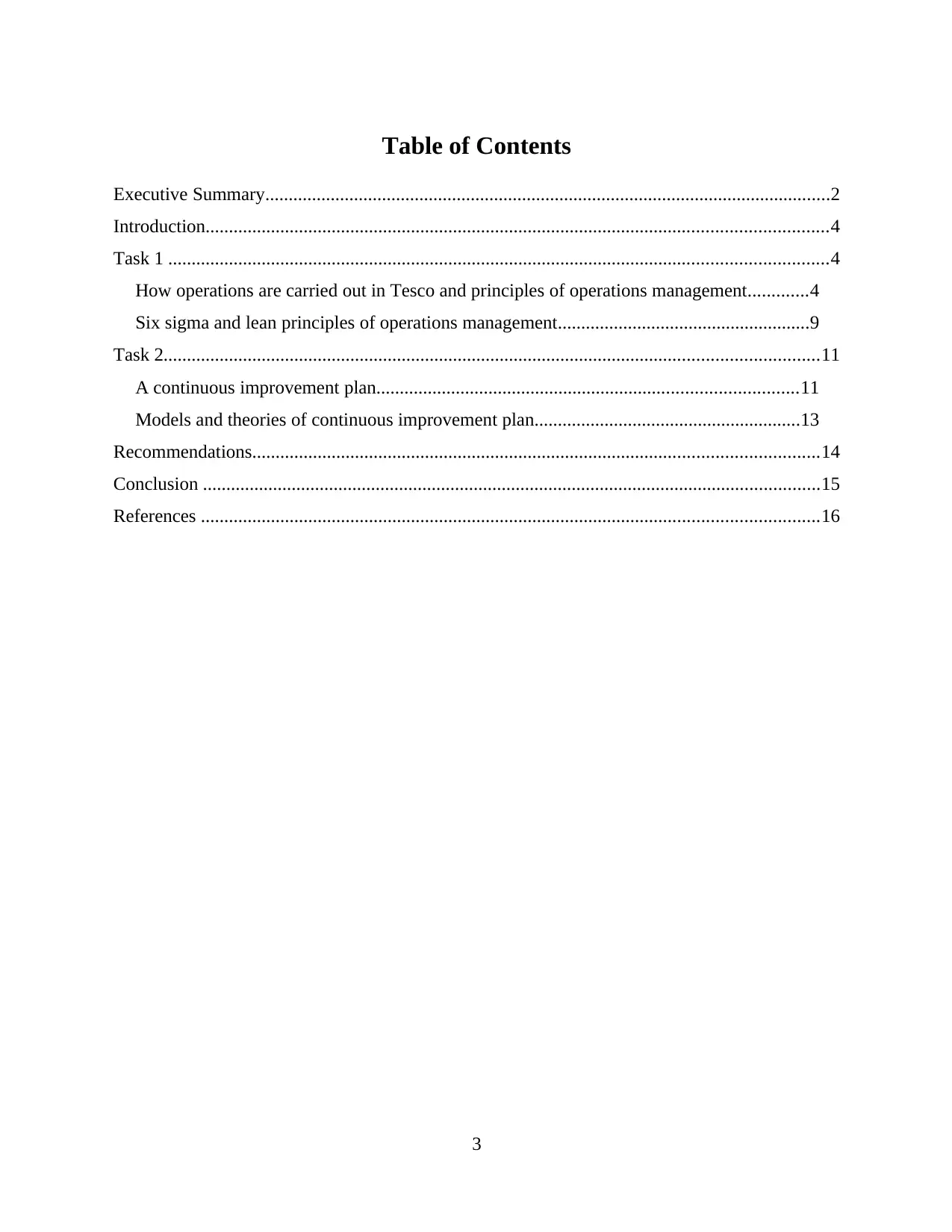
Table of Contents
Executive Summary.........................................................................................................................2
Introduction.....................................................................................................................................4
Task 1 .............................................................................................................................................4
How operations are carried out in Tesco and principles of operations management.............4
Six sigma and lean principles of operations management......................................................9
Task 2............................................................................................................................................11
A continuous improvement plan..........................................................................................11
Models and theories of continuous improvement plan.........................................................13
Recommendations.........................................................................................................................14
Conclusion ....................................................................................................................................15
References ....................................................................................................................................16
3
Executive Summary.........................................................................................................................2
Introduction.....................................................................................................................................4
Task 1 .............................................................................................................................................4
How operations are carried out in Tesco and principles of operations management.............4
Six sigma and lean principles of operations management......................................................9
Task 2............................................................................................................................................11
A continuous improvement plan..........................................................................................11
Models and theories of continuous improvement plan.........................................................13
Recommendations.........................................................................................................................14
Conclusion ....................................................................................................................................15
References ....................................................................................................................................16
3
⊘ This is a preview!⊘
Do you want full access?
Subscribe today to unlock all pages.

Trusted by 1+ million students worldwide
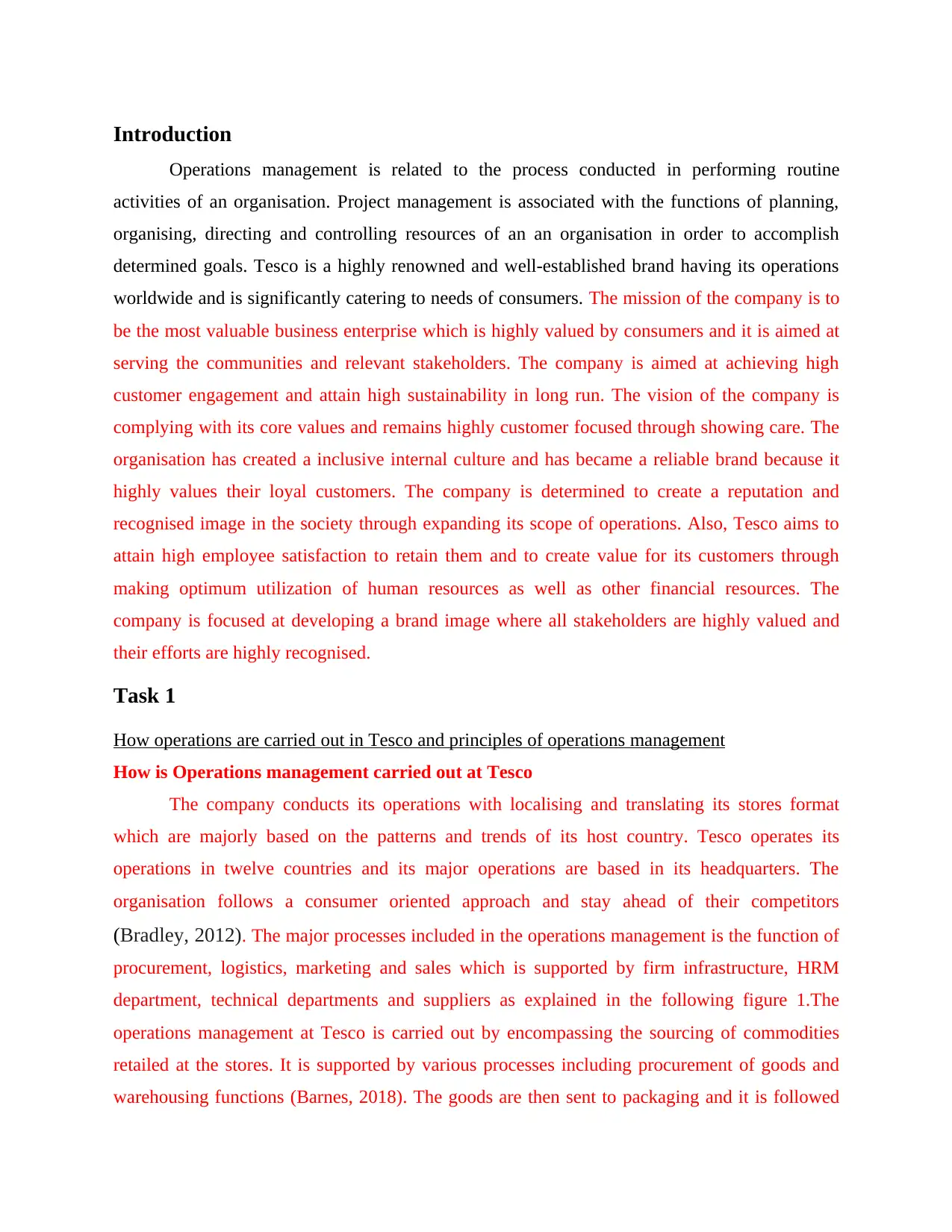
Introduction
Operations management is related to the process conducted in performing routine
activities of an organisation. Project management is associated with the functions of planning,
organising, directing and controlling resources of an an organisation in order to accomplish
determined goals. Tesco is a highly renowned and well-established brand having its operations
worldwide and is significantly catering to needs of consumers. The mission of the company is to
be the most valuable business enterprise which is highly valued by consumers and it is aimed at
serving the communities and relevant stakeholders. The company is aimed at achieving high
customer engagement and attain high sustainability in long run. The vision of the company is
complying with its core values and remains highly customer focused through showing care. The
organisation has created a inclusive internal culture and has became a reliable brand because it
highly values their loyal customers. The company is determined to create a reputation and
recognised image in the society through expanding its scope of operations. Also, Tesco aims to
attain high employee satisfaction to retain them and to create value for its customers through
making optimum utilization of human resources as well as other financial resources. The
company is focused at developing a brand image where all stakeholders are highly valued and
their efforts are highly recognised.
Task 1
How operations are carried out in Tesco and principles of operations management
How is Operations management carried out at Tesco
The company conducts its operations with localising and translating its stores format
which are majorly based on the patterns and trends of its host country. Tesco operates its
operations in twelve countries and its major operations are based in its headquarters. The
organisation follows a consumer oriented approach and stay ahead of their competitors
(Bradley, 2012). The major processes included in the operations management is the function of
procurement, logistics, marketing and sales which is supported by firm infrastructure, HRM
department, technical departments and suppliers as explained in the following figure 1.The
operations management at Tesco is carried out by encompassing the sourcing of commodities
retailed at the stores. It is supported by various processes including procurement of goods and
warehousing functions (Barnes, 2018). The goods are then sent to packaging and it is followed
Operations management is related to the process conducted in performing routine
activities of an organisation. Project management is associated with the functions of planning,
organising, directing and controlling resources of an an organisation in order to accomplish
determined goals. Tesco is a highly renowned and well-established brand having its operations
worldwide and is significantly catering to needs of consumers. The mission of the company is to
be the most valuable business enterprise which is highly valued by consumers and it is aimed at
serving the communities and relevant stakeholders. The company is aimed at achieving high
customer engagement and attain high sustainability in long run. The vision of the company is
complying with its core values and remains highly customer focused through showing care. The
organisation has created a inclusive internal culture and has became a reliable brand because it
highly values their loyal customers. The company is determined to create a reputation and
recognised image in the society through expanding its scope of operations. Also, Tesco aims to
attain high employee satisfaction to retain them and to create value for its customers through
making optimum utilization of human resources as well as other financial resources. The
company is focused at developing a brand image where all stakeholders are highly valued and
their efforts are highly recognised.
Task 1
How operations are carried out in Tesco and principles of operations management
How is Operations management carried out at Tesco
The company conducts its operations with localising and translating its stores format
which are majorly based on the patterns and trends of its host country. Tesco operates its
operations in twelve countries and its major operations are based in its headquarters. The
organisation follows a consumer oriented approach and stay ahead of their competitors
(Bradley, 2012). The major processes included in the operations management is the function of
procurement, logistics, marketing and sales which is supported by firm infrastructure, HRM
department, technical departments and suppliers as explained in the following figure 1.The
operations management at Tesco is carried out by encompassing the sourcing of commodities
retailed at the stores. It is supported by various processes including procurement of goods and
warehousing functions (Barnes, 2018). The goods are then sent to packaging and it is followed
Paraphrase This Document
Need a fresh take? Get an instant paraphrase of this document with our AI Paraphraser
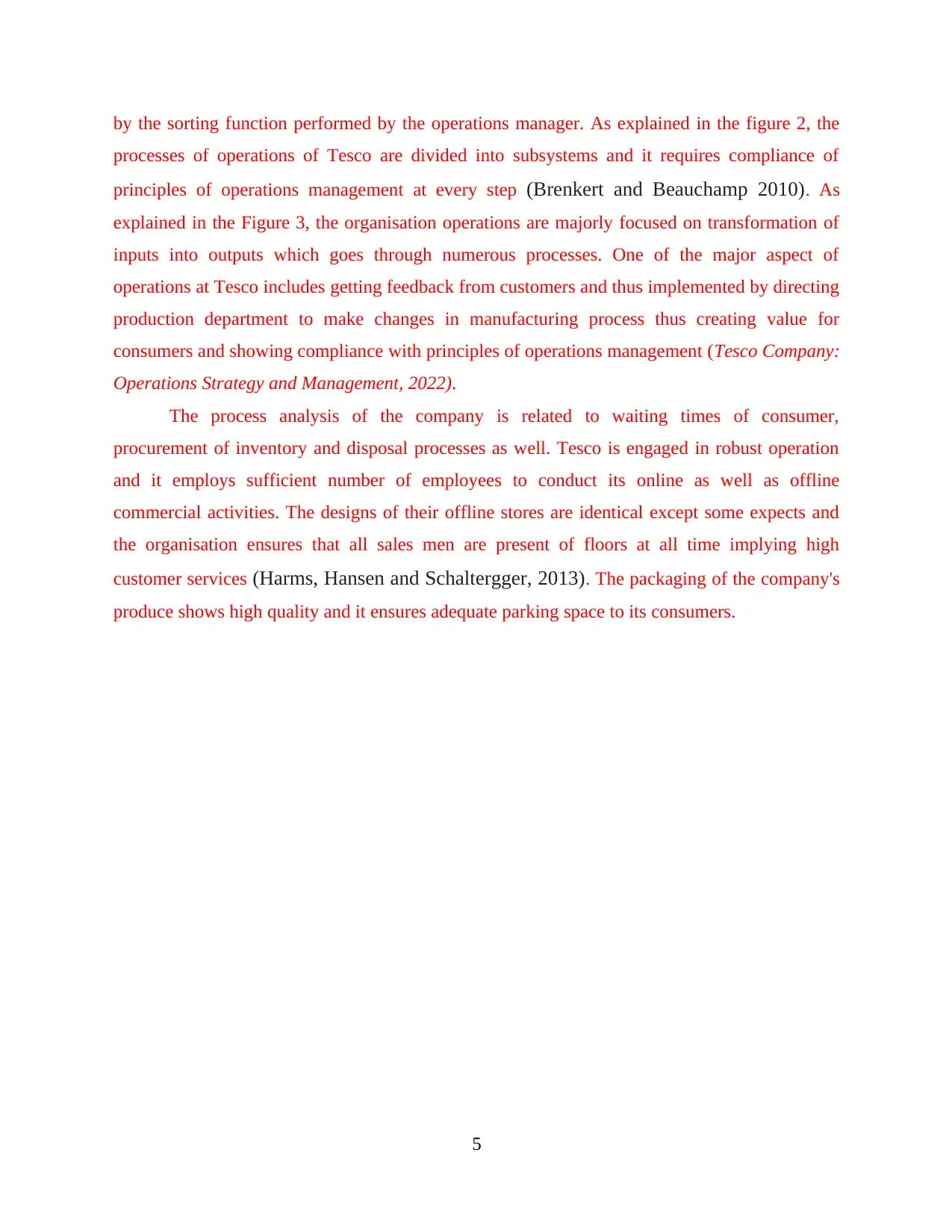
by the sorting function performed by the operations manager. As explained in the figure 2, the
processes of operations of Tesco are divided into subsystems and it requires compliance of
principles of operations management at every step (Brenkert and Beauchamp 2010). As
explained in the Figure 3, the organisation operations are majorly focused on transformation of
inputs into outputs which goes through numerous processes. One of the major aspect of
operations at Tesco includes getting feedback from customers and thus implemented by directing
production department to make changes in manufacturing process thus creating value for
consumers and showing compliance with principles of operations management (Tesco Company:
Operations Strategy and Management, 2022).
The process analysis of the company is related to waiting times of consumer,
procurement of inventory and disposal processes as well. Tesco is engaged in robust operation
and it employs sufficient number of employees to conduct its online as well as offline
commercial activities. The designs of their offline stores are identical except some expects and
the organisation ensures that all sales men are present of floors at all time implying high
customer services (Harms, Hansen and Schaltergger, 2013). The packaging of the company's
produce shows high quality and it ensures adequate parking space to its consumers.
5
processes of operations of Tesco are divided into subsystems and it requires compliance of
principles of operations management at every step (Brenkert and Beauchamp 2010). As
explained in the Figure 3, the organisation operations are majorly focused on transformation of
inputs into outputs which goes through numerous processes. One of the major aspect of
operations at Tesco includes getting feedback from customers and thus implemented by directing
production department to make changes in manufacturing process thus creating value for
consumers and showing compliance with principles of operations management (Tesco Company:
Operations Strategy and Management, 2022).
The process analysis of the company is related to waiting times of consumer,
procurement of inventory and disposal processes as well. Tesco is engaged in robust operation
and it employs sufficient number of employees to conduct its online as well as offline
commercial activities. The designs of their offline stores are identical except some expects and
the organisation ensures that all sales men are present of floors at all time implying high
customer services (Harms, Hansen and Schaltergger, 2013). The packaging of the company's
produce shows high quality and it ensures adequate parking space to its consumers.
5
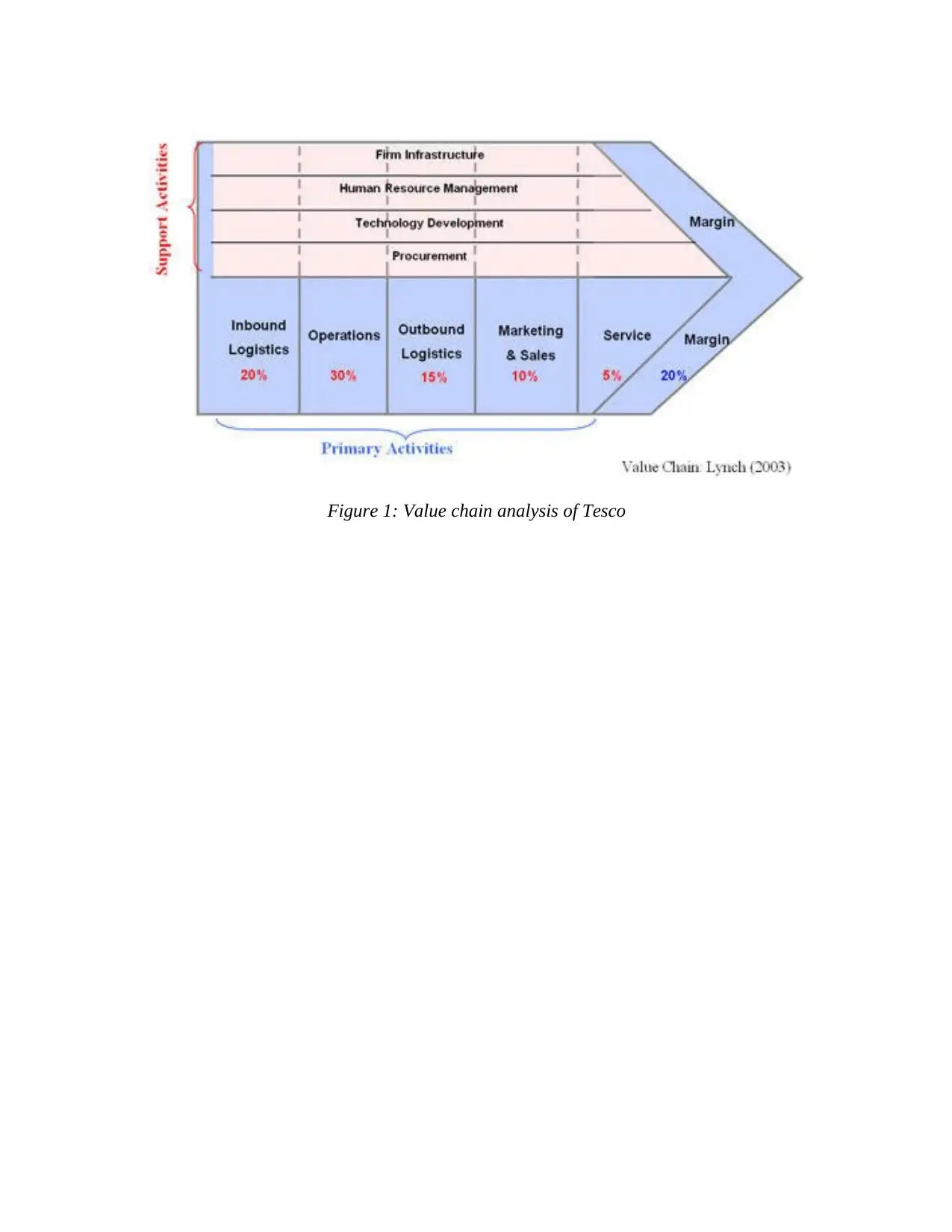
Figure 1: Value chain analysis of Tesco
⊘ This is a preview!⊘
Do you want full access?
Subscribe today to unlock all pages.

Trusted by 1+ million students worldwide
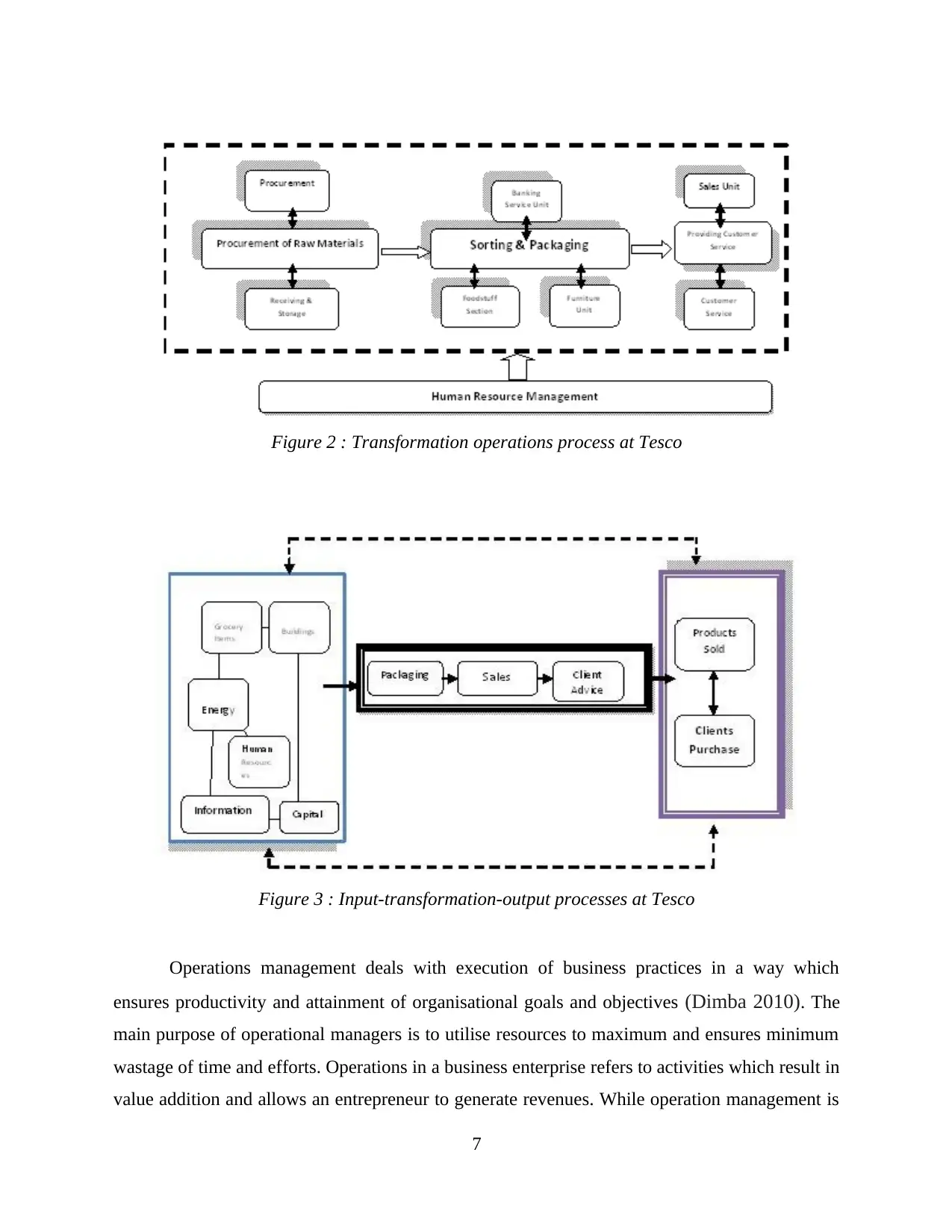
Operations management deals with execution of business practices in a way which
ensures productivity and attainment of organisational goals and objectives (Dimba 2010). The
main purpose of operational managers is to utilise resources to maximum and ensures minimum
wastage of time and efforts. Operations in a business enterprise refers to activities which result in
value addition and allows an entrepreneur to generate revenues. While operation management is
7
Figure 2 : Transformation operations process at Tesco
Figure 3 : Input-transformation-output processes at Tesco
ensures productivity and attainment of organisational goals and objectives (Dimba 2010). The
main purpose of operational managers is to utilise resources to maximum and ensures minimum
wastage of time and efforts. Operations in a business enterprise refers to activities which result in
value addition and allows an entrepreneur to generate revenues. While operation management is
7
Figure 2 : Transformation operations process at Tesco
Figure 3 : Input-transformation-output processes at Tesco
Paraphrase This Document
Need a fresh take? Get an instant paraphrase of this document with our AI Paraphraser
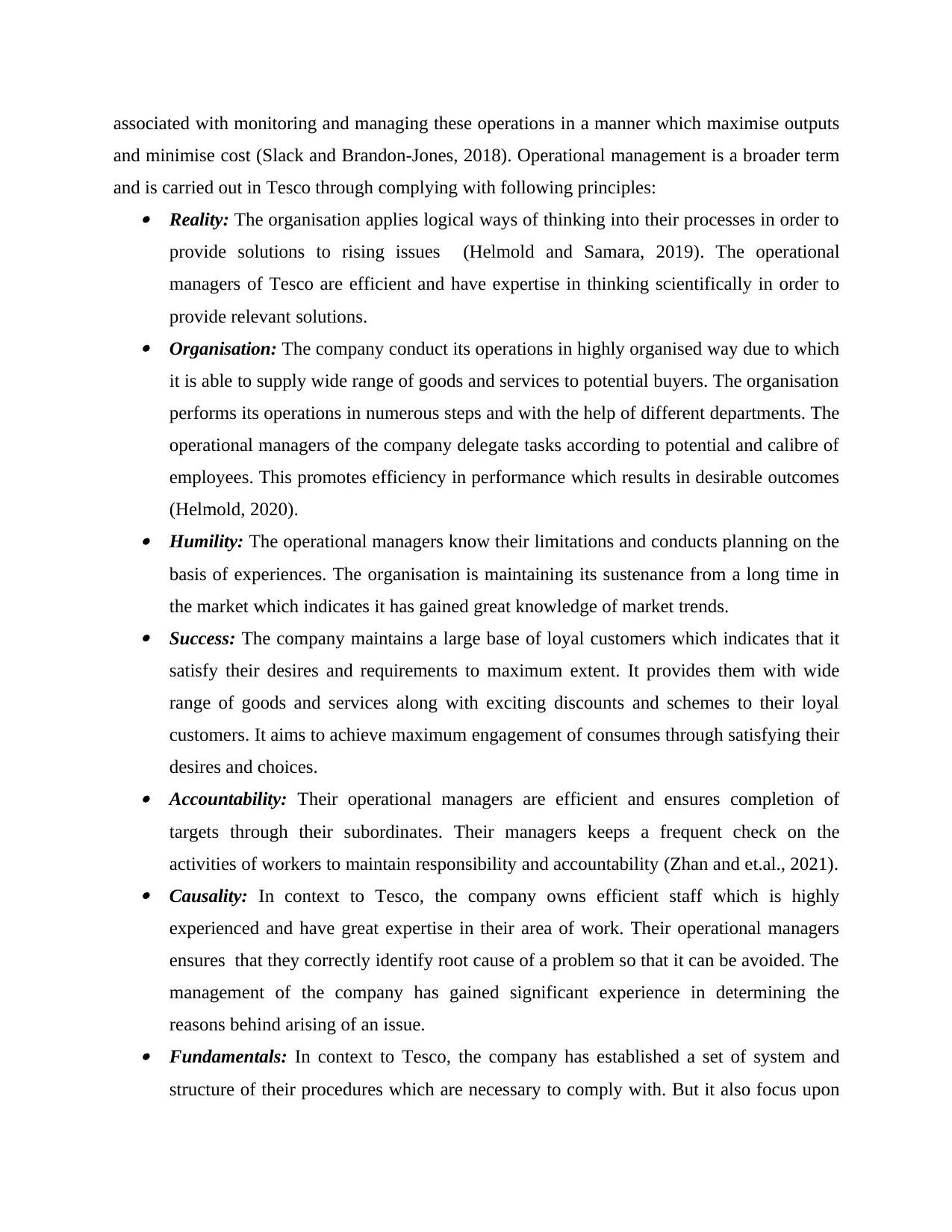
associated with monitoring and managing these operations in a manner which maximise outputs
and minimise cost (Slack and Brandon-Jones, 2018). Operational management is a broader term
and is carried out in Tesco through complying with following principles: Reality: The organisation applies logical ways of thinking into their processes in order to
provide solutions to rising issues (Helmold and Samara, 2019). The operational
managers of Tesco are efficient and have expertise in thinking scientifically in order to
provide relevant solutions. Organisation: The company conduct its operations in highly organised way due to which
it is able to supply wide range of goods and services to potential buyers. The organisation
performs its operations in numerous steps and with the help of different departments. The
operational managers of the company delegate tasks according to potential and calibre of
employees. This promotes efficiency in performance which results in desirable outcomes
(Helmold, 2020). Humility: The operational managers know their limitations and conducts planning on the
basis of experiences. The organisation is maintaining its sustenance from a long time in
the market which indicates it has gained great knowledge of market trends. Success: The company maintains a large base of loyal customers which indicates that it
satisfy their desires and requirements to maximum extent. It provides them with wide
range of goods and services along with exciting discounts and schemes to their loyal
customers. It aims to achieve maximum engagement of consumes through satisfying their
desires and choices. Accountability: Their operational managers are efficient and ensures completion of
targets through their subordinates. Their managers keeps a frequent check on the
activities of workers to maintain responsibility and accountability (Zhan and et.al., 2021). Causality: In context to Tesco, the company owns efficient staff which is highly
experienced and have great expertise in their area of work. Their operational managers
ensures that they correctly identify root cause of a problem so that it can be avoided. The
management of the company has gained significant experience in determining the
reasons behind arising of an issue. Fundamentals: In context to Tesco, the company has established a set of system and
structure of their procedures which are necessary to comply with. But it also focus upon
and minimise cost (Slack and Brandon-Jones, 2018). Operational management is a broader term
and is carried out in Tesco through complying with following principles: Reality: The organisation applies logical ways of thinking into their processes in order to
provide solutions to rising issues (Helmold and Samara, 2019). The operational
managers of Tesco are efficient and have expertise in thinking scientifically in order to
provide relevant solutions. Organisation: The company conduct its operations in highly organised way due to which
it is able to supply wide range of goods and services to potential buyers. The organisation
performs its operations in numerous steps and with the help of different departments. The
operational managers of the company delegate tasks according to potential and calibre of
employees. This promotes efficiency in performance which results in desirable outcomes
(Helmold, 2020). Humility: The operational managers know their limitations and conducts planning on the
basis of experiences. The organisation is maintaining its sustenance from a long time in
the market which indicates it has gained great knowledge of market trends. Success: The company maintains a large base of loyal customers which indicates that it
satisfy their desires and requirements to maximum extent. It provides them with wide
range of goods and services along with exciting discounts and schemes to their loyal
customers. It aims to achieve maximum engagement of consumes through satisfying their
desires and choices. Accountability: Their operational managers are efficient and ensures completion of
targets through their subordinates. Their managers keeps a frequent check on the
activities of workers to maintain responsibility and accountability (Zhan and et.al., 2021). Causality: In context to Tesco, the company owns efficient staff which is highly
experienced and have great expertise in their area of work. Their operational managers
ensures that they correctly identify root cause of a problem so that it can be avoided. The
management of the company has gained significant experience in determining the
reasons behind arising of an issue. Fundamentals: In context to Tesco, the company has established a set of system and
structure of their procedures which are necessary to comply with. But it also focus upon
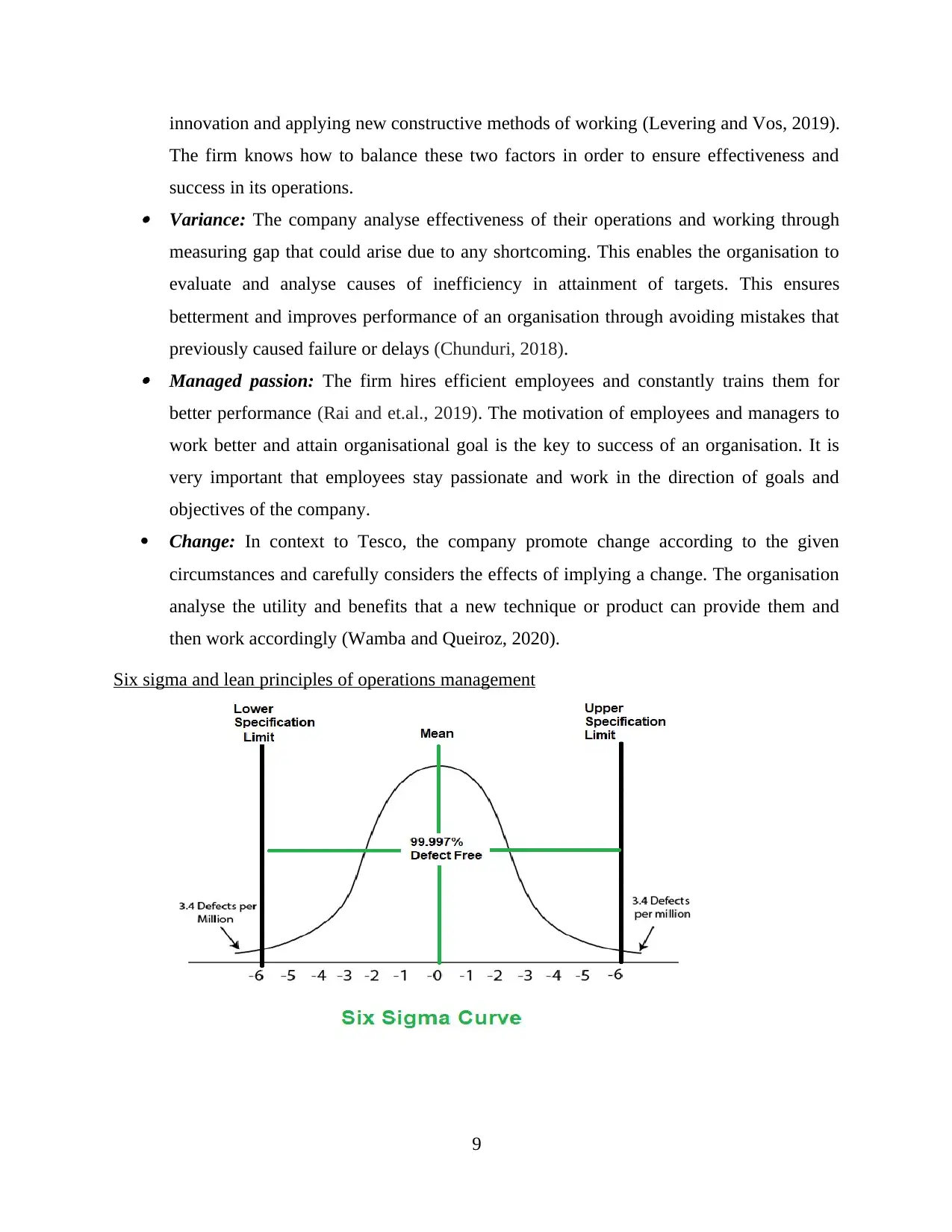
innovation and applying new constructive methods of working (Levering and Vos, 2019).
The firm knows how to balance these two factors in order to ensure effectiveness and
success in its operations. Variance: The company analyse effectiveness of their operations and working through
measuring gap that could arise due to any shortcoming. This enables the organisation to
evaluate and analyse causes of inefficiency in attainment of targets. This ensures
betterment and improves performance of an organisation through avoiding mistakes that
previously caused failure or delays (Chunduri, 2018). Managed passion: The firm hires efficient employees and constantly trains them for
better performance (Rai and et.al., 2019). The motivation of employees and managers to
work better and attain organisational goal is the key to success of an organisation. It is
very important that employees stay passionate and work in the direction of goals and
objectives of the company.
Change: In context to Tesco, the company promote change according to the given
circumstances and carefully considers the effects of implying a change. The organisation
analyse the utility and benefits that a new technique or product can provide them and
then work accordingly (Wamba and Queiroz, 2020).
Six sigma and lean principles of operations management
9
The firm knows how to balance these two factors in order to ensure effectiveness and
success in its operations. Variance: The company analyse effectiveness of their operations and working through
measuring gap that could arise due to any shortcoming. This enables the organisation to
evaluate and analyse causes of inefficiency in attainment of targets. This ensures
betterment and improves performance of an organisation through avoiding mistakes that
previously caused failure or delays (Chunduri, 2018). Managed passion: The firm hires efficient employees and constantly trains them for
better performance (Rai and et.al., 2019). The motivation of employees and managers to
work better and attain organisational goal is the key to success of an organisation. It is
very important that employees stay passionate and work in the direction of goals and
objectives of the company.
Change: In context to Tesco, the company promote change according to the given
circumstances and carefully considers the effects of implying a change. The organisation
analyse the utility and benefits that a new technique or product can provide them and
then work accordingly (Wamba and Queiroz, 2020).
Six sigma and lean principles of operations management
9
⊘ This is a preview!⊘
Do you want full access?
Subscribe today to unlock all pages.

Trusted by 1+ million students worldwide
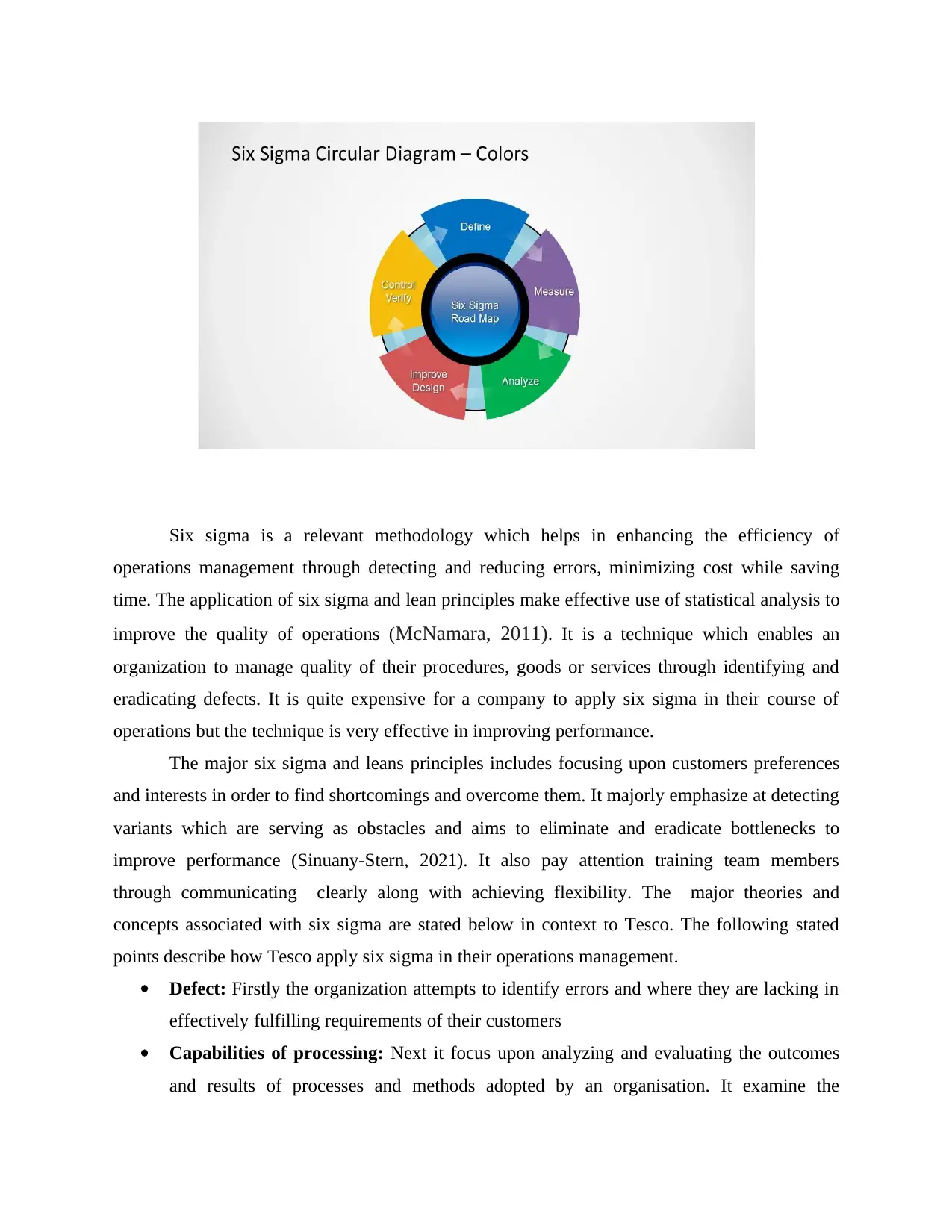
Six sigma is a relevant methodology which helps in enhancing the efficiency of
operations management through detecting and reducing errors, minimizing cost while saving
time. The application of six sigma and lean principles make effective use of statistical analysis to
improve the quality of operations (McNamara, 2011). It is a technique which enables an
organization to manage quality of their procedures, goods or services through identifying and
eradicating defects. It is quite expensive for a company to apply six sigma in their course of
operations but the technique is very effective in improving performance.
The major six sigma and leans principles includes focusing upon customers preferences
and interests in order to find shortcomings and overcome them. It majorly emphasize at detecting
variants which are serving as obstacles and aims to eliminate and eradicate bottlenecks to
improve performance (Sinuany-Stern, 2021). It also pay attention training team members
through communicating clearly along with achieving flexibility. The major theories and
concepts associated with six sigma are stated below in context to Tesco. The following stated
points describe how Tesco apply six sigma in their operations management.
Defect: Firstly the organization attempts to identify errors and where they are lacking in
effectively fulfilling requirements of their customers
Capabilities of processing: Next it focus upon analyzing and evaluating the outcomes
and results of processes and methods adopted by an organisation. It examine the
operations management through detecting and reducing errors, minimizing cost while saving
time. The application of six sigma and lean principles make effective use of statistical analysis to
improve the quality of operations (McNamara, 2011). It is a technique which enables an
organization to manage quality of their procedures, goods or services through identifying and
eradicating defects. It is quite expensive for a company to apply six sigma in their course of
operations but the technique is very effective in improving performance.
The major six sigma and leans principles includes focusing upon customers preferences
and interests in order to find shortcomings and overcome them. It majorly emphasize at detecting
variants which are serving as obstacles and aims to eliminate and eradicate bottlenecks to
improve performance (Sinuany-Stern, 2021). It also pay attention training team members
through communicating clearly along with achieving flexibility. The major theories and
concepts associated with six sigma are stated below in context to Tesco. The following stated
points describe how Tesco apply six sigma in their operations management.
Defect: Firstly the organization attempts to identify errors and where they are lacking in
effectively fulfilling requirements of their customers
Capabilities of processing: Next it focus upon analyzing and evaluating the outcomes
and results of processes and methods adopted by an organisation. It examine the
Paraphrase This Document
Need a fresh take? Get an instant paraphrase of this document with our AI Paraphraser
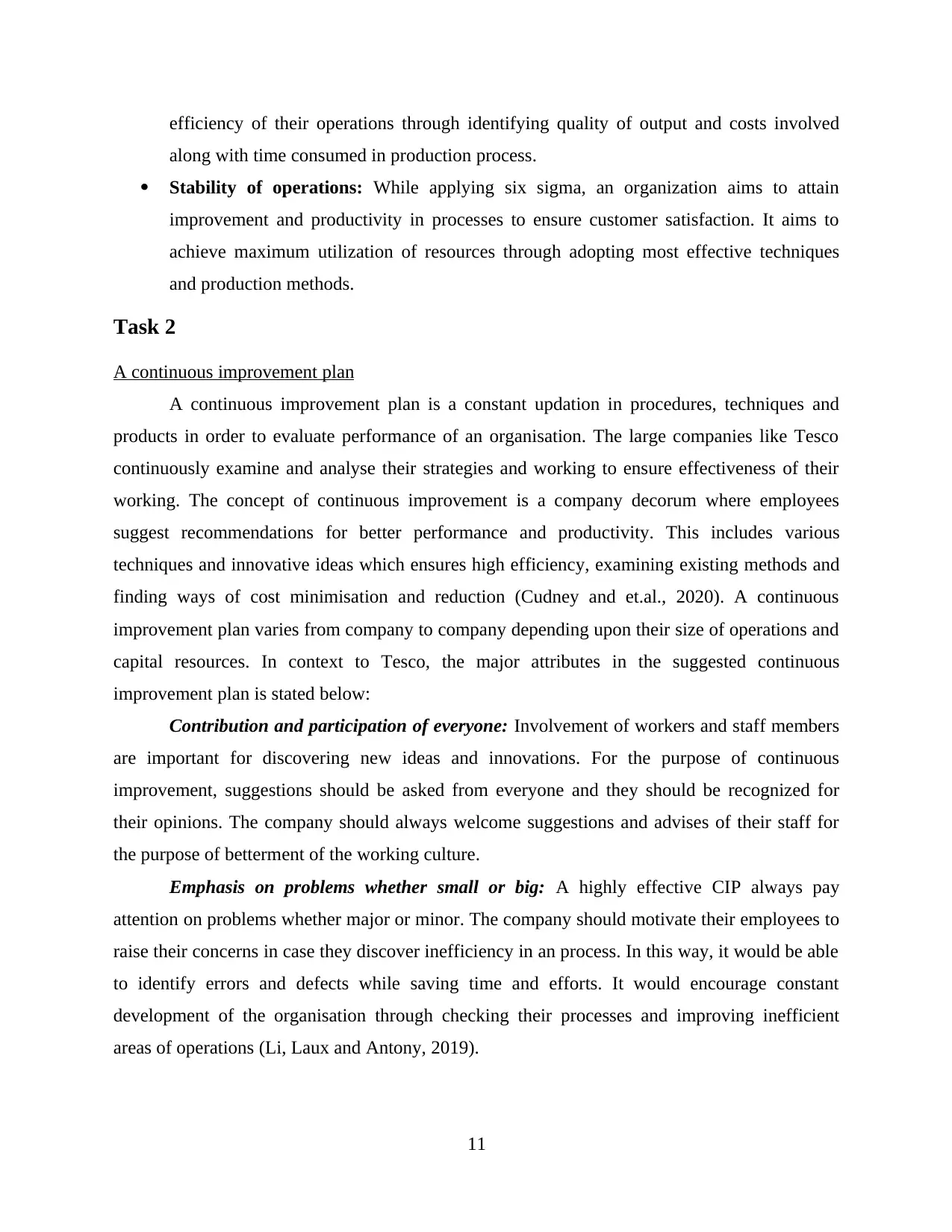
efficiency of their operations through identifying quality of output and costs involved
along with time consumed in production process.
Stability of operations: While applying six sigma, an organization aims to attain
improvement and productivity in processes to ensure customer satisfaction. It aims to
achieve maximum utilization of resources through adopting most effective techniques
and production methods.
Task 2
A continuous improvement plan
A continuous improvement plan is a constant updation in procedures, techniques and
products in order to evaluate performance of an organisation. The large companies like Tesco
continuously examine and analyse their strategies and working to ensure effectiveness of their
working. The concept of continuous improvement is a company decorum where employees
suggest recommendations for better performance and productivity. This includes various
techniques and innovative ideas which ensures high efficiency, examining existing methods and
finding ways of cost minimisation and reduction (Cudney and et.al., 2020). A continuous
improvement plan varies from company to company depending upon their size of operations and
capital resources. In context to Tesco, the major attributes in the suggested continuous
improvement plan is stated below:
Contribution and participation of everyone: Involvement of workers and staff members
are important for discovering new ideas and innovations. For the purpose of continuous
improvement, suggestions should be asked from everyone and they should be recognized for
their opinions. The company should always welcome suggestions and advises of their staff for
the purpose of betterment of the working culture.
Emphasis on problems whether small or big: A highly effective CIP always pay
attention on problems whether major or minor. The company should motivate their employees to
raise their concerns in case they discover inefficiency in an process. In this way, it would be able
to identify errors and defects while saving time and efforts. It would encourage constant
development of the organisation through checking their processes and improving inefficient
areas of operations (Li, Laux and Antony, 2019).
11
along with time consumed in production process.
Stability of operations: While applying six sigma, an organization aims to attain
improvement and productivity in processes to ensure customer satisfaction. It aims to
achieve maximum utilization of resources through adopting most effective techniques
and production methods.
Task 2
A continuous improvement plan
A continuous improvement plan is a constant updation in procedures, techniques and
products in order to evaluate performance of an organisation. The large companies like Tesco
continuously examine and analyse their strategies and working to ensure effectiveness of their
working. The concept of continuous improvement is a company decorum where employees
suggest recommendations for better performance and productivity. This includes various
techniques and innovative ideas which ensures high efficiency, examining existing methods and
finding ways of cost minimisation and reduction (Cudney and et.al., 2020). A continuous
improvement plan varies from company to company depending upon their size of operations and
capital resources. In context to Tesco, the major attributes in the suggested continuous
improvement plan is stated below:
Contribution and participation of everyone: Involvement of workers and staff members
are important for discovering new ideas and innovations. For the purpose of continuous
improvement, suggestions should be asked from everyone and they should be recognized for
their opinions. The company should always welcome suggestions and advises of their staff for
the purpose of betterment of the working culture.
Emphasis on problems whether small or big: A highly effective CIP always pay
attention on problems whether major or minor. The company should motivate their employees to
raise their concerns in case they discover inefficiency in an process. In this way, it would be able
to identify errors and defects while saving time and efforts. It would encourage constant
development of the organisation through checking their processes and improving inefficient
areas of operations (Li, Laux and Antony, 2019).
11
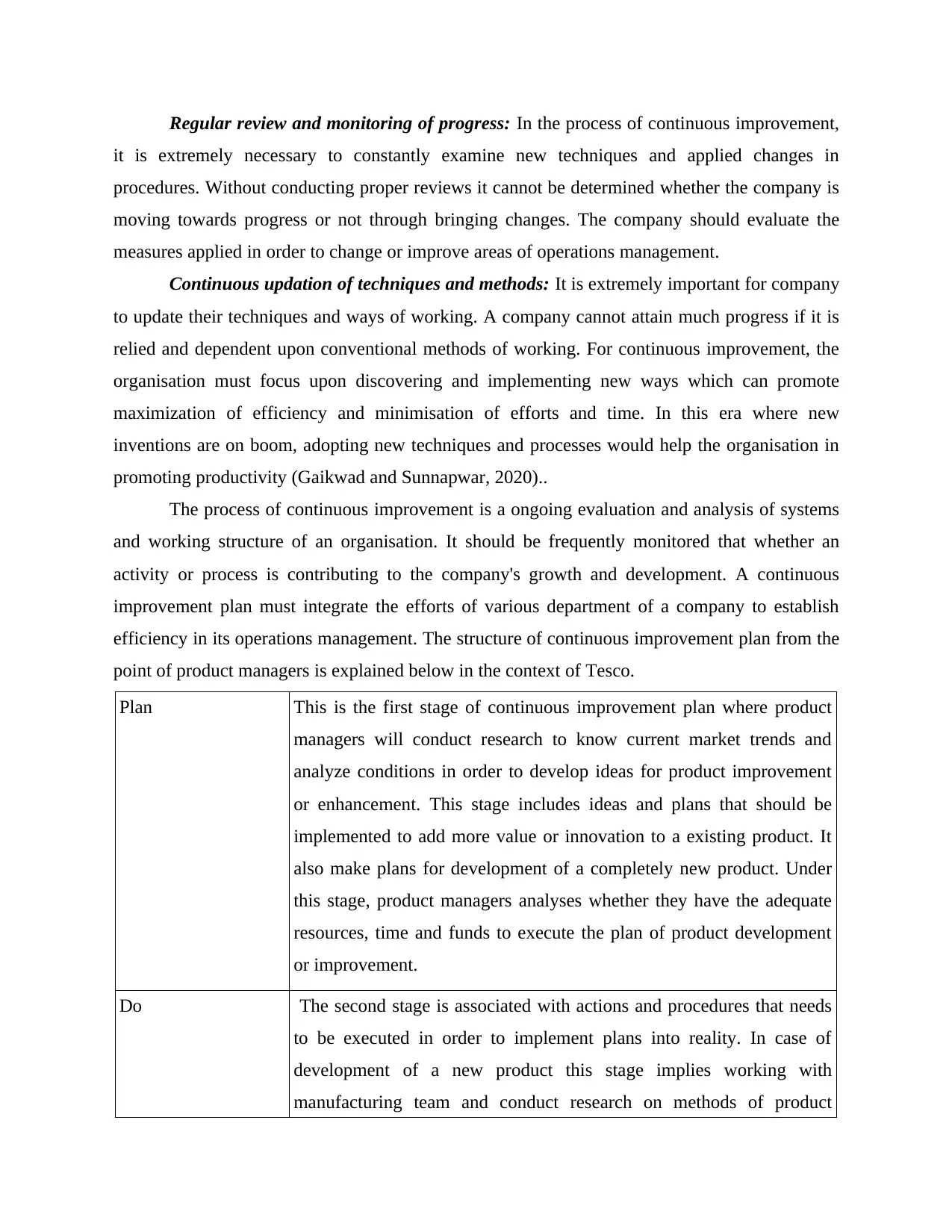
Regular review and monitoring of progress: In the process of continuous improvement,
it is extremely necessary to constantly examine new techniques and applied changes in
procedures. Without conducting proper reviews it cannot be determined whether the company is
moving towards progress or not through bringing changes. The company should evaluate the
measures applied in order to change or improve areas of operations management.
Continuous updation of techniques and methods: It is extremely important for company
to update their techniques and ways of working. A company cannot attain much progress if it is
relied and dependent upon conventional methods of working. For continuous improvement, the
organisation must focus upon discovering and implementing new ways which can promote
maximization of efficiency and minimisation of efforts and time. In this era where new
inventions are on boom, adopting new techniques and processes would help the organisation in
promoting productivity (Gaikwad and Sunnapwar, 2020)..
The process of continuous improvement is a ongoing evaluation and analysis of systems
and working structure of an organisation. It should be frequently monitored that whether an
activity or process is contributing to the company's growth and development. A continuous
improvement plan must integrate the efforts of various department of a company to establish
efficiency in its operations management. The structure of continuous improvement plan from the
point of product managers is explained below in the context of Tesco.
Plan This is the first stage of continuous improvement plan where product
managers will conduct research to know current market trends and
analyze conditions in order to develop ideas for product improvement
or enhancement. This stage includes ideas and plans that should be
implemented to add more value or innovation to a existing product. It
also make plans for development of a completely new product. Under
this stage, product managers analyses whether they have the adequate
resources, time and funds to execute the plan of product development
or improvement.
Do The second stage is associated with actions and procedures that needs
to be executed in order to implement plans into reality. In case of
development of a new product this stage implies working with
manufacturing team and conduct research on methods of product
it is extremely necessary to constantly examine new techniques and applied changes in
procedures. Without conducting proper reviews it cannot be determined whether the company is
moving towards progress or not through bringing changes. The company should evaluate the
measures applied in order to change or improve areas of operations management.
Continuous updation of techniques and methods: It is extremely important for company
to update their techniques and ways of working. A company cannot attain much progress if it is
relied and dependent upon conventional methods of working. For continuous improvement, the
organisation must focus upon discovering and implementing new ways which can promote
maximization of efficiency and minimisation of efforts and time. In this era where new
inventions are on boom, adopting new techniques and processes would help the organisation in
promoting productivity (Gaikwad and Sunnapwar, 2020)..
The process of continuous improvement is a ongoing evaluation and analysis of systems
and working structure of an organisation. It should be frequently monitored that whether an
activity or process is contributing to the company's growth and development. A continuous
improvement plan must integrate the efforts of various department of a company to establish
efficiency in its operations management. The structure of continuous improvement plan from the
point of product managers is explained below in the context of Tesco.
Plan This is the first stage of continuous improvement plan where product
managers will conduct research to know current market trends and
analyze conditions in order to develop ideas for product improvement
or enhancement. This stage includes ideas and plans that should be
implemented to add more value or innovation to a existing product. It
also make plans for development of a completely new product. Under
this stage, product managers analyses whether they have the adequate
resources, time and funds to execute the plan of product development
or improvement.
Do The second stage is associated with actions and procedures that needs
to be executed in order to implement plans into reality. In case of
development of a new product this stage implies working with
manufacturing team and conduct research on methods of product
⊘ This is a preview!⊘
Do you want full access?
Subscribe today to unlock all pages.

Trusted by 1+ million students worldwide
1 out of 18
Related Documents
Your All-in-One AI-Powered Toolkit for Academic Success.
+13062052269
info@desklib.com
Available 24*7 on WhatsApp / Email
![[object Object]](/_next/static/media/star-bottom.7253800d.svg)
Unlock your academic potential
Copyright © 2020–2025 A2Z Services. All Rights Reserved. Developed and managed by ZUCOL.



